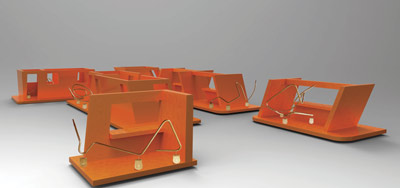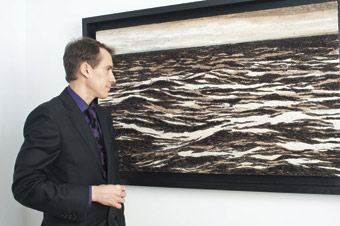According to various seasoned Cuban artists and curators, one of the greatest weaknesses of our artistic field in the face of the international competition for exposé, positioning in the market, fairs and top-notch exhibition circuits, is no doubt the lack of art collections –either private or institutional- good enough to support, sponsor and promote, that is, contribute to launch national artistic creation into the international circuits.
 Amid that bleak panorama –as far as private collections are concerned- the name of a man and his project are beginning to get some media hype in Havana’s artistic realm: Jose Busto and his Avistamientos (Sightings) Gallery. Born in Havana on March 23, 1969, Busto is a peculiar, one-of-a-kind Cuban. Hailing from a refined family education, he gives center stage importance to the role played by esthetics in all aspects of a man’s life. That explains his one-and-only clothes, marked by a formal elegance that becomes an esthetic expression of his singular personality. Busto is an elegant Cuban who wears a three-piece suit when attending exhibits, no matter the sweltering sun that beats down on this island nation, the malfunctioning air-conditioning systems or the enthusiastic crowds. He clings to his faultless formality and that makes him a genuine being.
Amid that bleak panorama –as far as private collections are concerned- the name of a man and his project are beginning to get some media hype in Havana’s artistic realm: Jose Busto and his Avistamientos (Sightings) Gallery. Born in Havana on March 23, 1969, Busto is a peculiar, one-of-a-kind Cuban. Hailing from a refined family education, he gives center stage importance to the role played by esthetics in all aspects of a man’s life. That explains his one-and-only clothes, marked by a formal elegance that becomes an esthetic expression of his singular personality. Busto is an elegant Cuban who wears a three-piece suit when attending exhibits, no matter the sweltering sun that beats down on this island nation, the malfunctioning air-conditioning systems or the enthusiastic crowds. He clings to his faultless formality and that makes him a genuine being.
In the early 1990s, Jose Busto entered the realm of art collections, though his preferences were European art and antiques of all kinds. By 1998, he acquired a liking for the national art and focused on the acquisition of artworks from the Cuban avant-garde. That was no doubt the necessary transition that eventually prompted Busto to buy his first piece of Cuban contemporary art at a State-run gallery back in 2004: Self-Portrait 6,by Jorge Lopez Pardo. The contact with this artist marked the beginning of his passion for collecting Cuban contemporary art. Busto says it was the experience of watching the artist in the creative process of another of his works, Avistamiento I, what actually unleashed a sudden passion that today rules his professional life. Lopez Pardo had painted an aircraft buried in a sugarcane field, but later and out of fit of anger, he unpainted the field with a coat of white paint to make it resemble the hazy high skies. Thus, the airplane was all of a sudden buried halfway into a thick layer of clouds, sighting God knows what unfathomable reality. Busto couldn’t resist the temptation and bought that work. After that, he hasn’t stopped –and the local artists don’t want him to stop. His current collection includes nearly two dozen top-tier Cuban artists. Some of the most celebrated names are Pedro Pablo Oliva, Roberto Fabelo, Rene Francisco, Jose Manuel Fors, Reynerio Tamayo and Carlos Quintana. From the breed of youngest artists, he boasts pieces from Yoan and Ivan Capote, Lidzie Alvisa, Rafael Villares, Mari Claudia Garcia, Kcho, R10, among others.
 Busto says that his decision of buying a particular piece is not ruled at all by the criteria of gallery owners, curators or critics. There has to be a special, instinctive connection between his existential world and the realm of feelings displayed in that piece. When that happens in an unsuspected way, he knows all along that piece is meant to be part of his collection. That’s how it worked with Yoan Capote’s Isla Pertenencia. Busto learned about that piece when it was nothing but a project sketch and he hanged in there until the artist finally had it done. This artwork has a very special meaning to him because Capote used Busto’s own blood to give the color pastes a pinkish tone that, together with an area made of fish hooks and bright white color, make up a brutal and choppy sea. A sea of hooks that seems to bleed; a frothy, non-sailable and desert sea. This is by and large a work of uneasy, thorny lyricism –even literally speaking- which speaks volumes of how Jose Busto’s intuitions are teeming with right esthetic decisions. From this same artist he has just bought Demagogia, one of the finest works –in my opinion- out of the Fonemas and Morfemas exhibit exposed at the Galeria Habana from late 2011 to early March this year. This is a brass basin shaped like a human ear that was installed in the gallery with running water and all corresponding accessories –like a bar of soap- for the public to make use of that artifact. As you watch the water run through the basin, we are brought to believe that is the same way the polluted phonic matter of demagogy falls into our own ears. If we prolong the metaphor out of metonymic contiguity, then we could liken the basin’s drainage system to our psychic systems: the place where all the lexical waste generated by society ends up in.
Busto says that his decision of buying a particular piece is not ruled at all by the criteria of gallery owners, curators or critics. There has to be a special, instinctive connection between his existential world and the realm of feelings displayed in that piece. When that happens in an unsuspected way, he knows all along that piece is meant to be part of his collection. That’s how it worked with Yoan Capote’s Isla Pertenencia. Busto learned about that piece when it was nothing but a project sketch and he hanged in there until the artist finally had it done. This artwork has a very special meaning to him because Capote used Busto’s own blood to give the color pastes a pinkish tone that, together with an area made of fish hooks and bright white color, make up a brutal and choppy sea. A sea of hooks that seems to bleed; a frothy, non-sailable and desert sea. This is by and large a work of uneasy, thorny lyricism –even literally speaking- which speaks volumes of how Jose Busto’s intuitions are teeming with right esthetic decisions. From this same artist he has just bought Demagogia, one of the finest works –in my opinion- out of the Fonemas and Morfemas exhibit exposed at the Galeria Habana from late 2011 to early March this year. This is a brass basin shaped like a human ear that was installed in the gallery with running water and all corresponding accessories –like a bar of soap- for the public to make use of that artifact. As you watch the water run through the basin, we are brought to believe that is the same way the polluted phonic matter of demagogy falls into our own ears. If we prolong the metaphor out of metonymic contiguity, then we could liken the basin’s drainage system to our psychic systems: the place where all the lexical waste generated by society ends up in.
In addition to his work as a professional art collector, about a year ago Busto started out a new project: Avistamientos (a gallery of Cuban contemporary art) with a basic goal of providing the youngest artists with material support for their own projects, let alone give himself a chance to promote a kind of art that still has no backing in the most legitimized and legitimizing institutional circuits. Since 2011 and through the course of the ongoing year, he has sponsored eleven artistic projects. Nine of them will be showcased in the upcoming edition of the Havana Biennial: La voluntad de los huéspedes, by Aluan Argüelles; Capital, by Reynaldo Echemendia; Con todo el gusto del mundo, by Grethell Rasua; Paisaje itinerante, by Rafael Villares; Fango, by Elizabet Cerviño; Inmersión, by Gabriela Garcya; and the collective project by 4ta Pragmática entitled Ciudad Generosa, that will be deployed at the desolated space of 3rd and E in Vedado, and in which Busto will be sponsoring three of the architectural interventions: PREié, by Victor Piverno, Humus, by Dania Gonzalez and Un exágono, by Fidel Yordan Castro.
As we can see, the contribution of projects like Avistamientos to our artistic context is simply impossible to reckon. A kind of collaboration and management in which Jose Busto is laying unprecedented foundations that appear to be the key to success for Cuba’s art field in the near future. Just like Lopez Pardo’s aircraft, Busto seems to be determined to look to the future –solid ground- in which private initiatives could have a say with all legal warranties –rubbing elbows with the state sponsorship- in developing the fine arts on the island nation. Just like the stiff airplane, he’s bidding with persistent patience in an effort to pry a path into the thick layer of clouds that still shrouds private art collections in Cuba.
Related Publications

How Harumi Yamaguchi invented the modern woman in Japan
March 16, 2022












